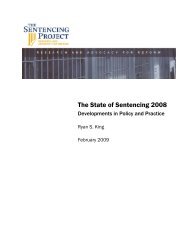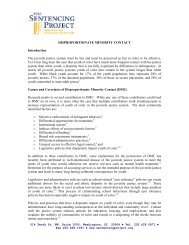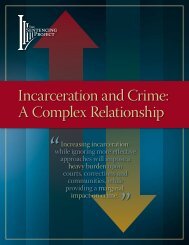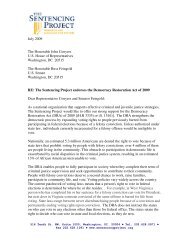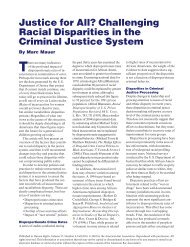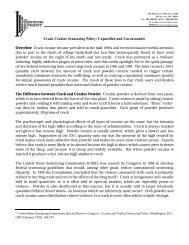VIEW PDF - The Sentencing Project
VIEW PDF - The Sentencing Project
VIEW PDF - The Sentencing Project
Create successful ePaper yourself
Turn your PDF publications into a flip-book with our unique Google optimized e-Paper software.
IV.<br />
Remove Youth from the Adult Criminal Justice System<br />
<strong>The</strong> Administration and OJJDP have not placed enough emphasis on addressing the<br />
needs of youth in the adult criminal justice system. Across the United States, an<br />
estimated 200,000 youth are tried, sentenced, or incarcerated in the adult criminal<br />
justice system every year. 26 Trying youth as adults is bad for public safety and for<br />
youth. Youth incarcerated in the adult system are more likely to reoffend than<br />
similarly situated youth who are retained in the juvenile system, and these offenses<br />
tend to be more violent. According to the federal Centers for Disease Control and<br />
Prevention, youth who are transferred from the juvenile court system to the adult<br />
criminal system are approximately 34% more likely than youth retained in the<br />
juvenile court system to be re‐arrested for violent or other crime. 27<br />
Youth in the adult system are also at great risk of sexual abuse and suicide when<br />
housed in adult jails and prisons. <strong>The</strong> National Prison Rape Elimination Commission<br />
found that “more than any other group of incarcerated persons, youth incarcerated<br />
with adults are probably at the highest risk for sexual abuse.” 28 Youth are also<br />
often placed in isolation, locked down 23 hours a day in small cells with no natural<br />
light, and these conditions cause anxiety, paranoia, and exacerbate existing mental<br />
disorders and heighten the risk of suicide. In fact, youth housed in adult jails are 36<br />
times more likely to commit suicide than are youth housed in juvenile detention<br />
facilities. 29<br />
<strong>The</strong> majorities of youth tried in the adult system are charged with non‐violent<br />
offenses, 30 and yet still suffer the lifelong consequences from an adult criminal<br />
conviction. Youth are often denied employment and educational opportunities 31<br />
which makes their transitions to adulthood difficult. If sentenced to an adult prison,<br />
approximately 80 percent of youth convicted as adults will be released from prison<br />
before their 21st birthdays, and 95 percent will be released before their 25th<br />
birthdays. 32 Many of these youth will not have been provided with the education<br />
and services they need to make a successful transition to productive adulthood.<br />
<strong>The</strong> Administration should provide strong leadership for states to reduce and<br />
eventually eliminate their harmful and dangerous reliance on trying youth as adults.<br />
Recommendations for the Obama Administration<br />
Fully Protect Youth in Adult Facilities from Sexual Abuse<br />
In accordance with the Prison Rape Elimination Act of 2003 (PREA), the Attorney<br />
General should enact standards to protect youth from sexual abuse. In light of the<br />
overwhelming evidence that youth cannot be kept safe in adult facilities and the<br />
research demonstrating that keeping youth in adult facilities is harmful to the youth<br />
and to public safety, the PREA standards should be modified to require removal of<br />
youth from adult jails and prisons altogether. This change would be consistent with<br />
9



